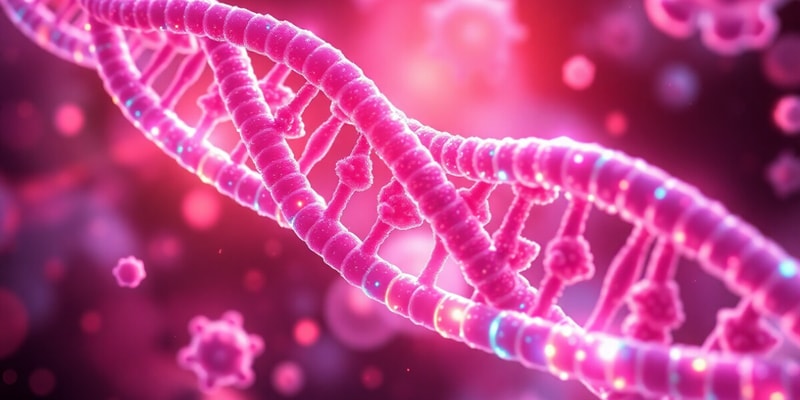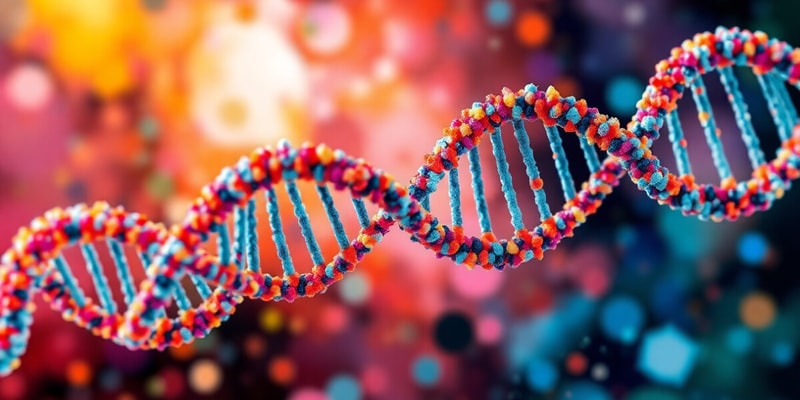Podcast
Questions and Answers
What is the primary purpose of gene probes in molecular techniques?
What is the primary purpose of gene probes in molecular techniques?
Which component is essential for the PCR method to function correctly?
Which component is essential for the PCR method to function correctly?
What technique is primarily used to analyze the size and quantity of DNA fragments?
What technique is primarily used to analyze the size and quantity of DNA fragments?
What does restriction fragment length polymorphism (RFLP) involve?
What does restriction fragment length polymorphism (RFLP) involve?
Signup and view all the answers
Which process uses antibodies to detect antigens within a tissue sample?
Which process uses antibodies to detect antigens within a tissue sample?
Signup and view all the answers
Study Notes
Recombinant DNA Technology in Microbiology
-
Gene Cloning: The process of creating multiple copies of a specific gene.
-
Steps:
- Isolation of the gene of interest: Using restriction enzymes and vectors.
- Insertion into a vector: Such as a plasmid or phage.
- Transformation into a host cell: Eg., bacteria or yeast.
- Selection of transformed cells: Identify cells that have successfully taken up the recombinant DNA.
- Growth of transformed host cells: Which will make copies of the gene of interest.
- Extraction and purification of the cloned gene: Or product made by its expression.
- Applications: Creating new proteins, improving existing ones, gene therapy, and agricultural engineering.
-
Steps:
-
Gene Probes: Short, labeled pieces of DNA or RNA used to identify and isolate specific genes.
-
Types:
- Oligonucleotide probes: Short sequences that are complementary to a specific target sequence.
- cDNA probes: Single-stranded DNA copies of mRNA, complementary to target RNA sequences.
- Riboprobes: RNA probes synthesized by a polymerase enzyme, complementary to target RNA sequences.
- Uses: Diagnosing genetic disorders, pathogen detection, and research.
-
Types:
-
Polymerase Chain Reaction (PCR): A technique used to amplify specific DNA sequences.
-
Components:
- DNA Template: The target DNA to be amplified.
- Primers: Short, single-stranded DNA sequences complementary to the target sequence.
- DNA Polymerase: An enzyme that synthesizes new DNA strands.
- Nucleotides: (dTNPs) Building blocks of DNA needed for replication.
-
Method:
- Denaturation: Separating the DNA strands.
- Annealing: Primers bind to the target sequence.
- Extension: Polymerase extends the primers to create new DNA strands.
-
Types:
- Real-time PCR: Quantifies the amount of DNA present before and after amplification.
- Nested PCR: Enhances sensitivity by performing two rounds of PCR with nested primers.
- Reverse transcription PCR (RT-PCR): Transcribes RNA into DNA, allowing for the amplification of RNA targets.
- Uses: Diagnosing infections, genetic testing, forensic science, and research.
-
Components:
-
Restriction Enzyme Analysis: The use of restriction enzymes to cut DNA at specific sequences.
- Uses: Mapping DNA, detecting mutations, identifying pathogens, and DNA fingerprinting.
-
Restriction Fragment Length Polymorphism (RFLP): Variations in DNA fragment lengths resulting from differences in restriction enzyme cut sites.
- Uses: Genetic mapping, paternity testing, forensics, and diagnostics.
-
Pulsed Field Gel Electrophoresis (PFGE): Used to separate large DNA molecules by applying alternating electric fields.
- Uses: Analyzing large genomes, tracking bacterial strains, and outbreak investigation.
-
Pyrosequencing: A sequencing method that detects the release of pyrophosphate during DNA synthesis.
- Uses: Clinical diagnostics, microbiome analysis, and research.
-
Next Generation Sequencing (NGS): High-throughput sequencing technologies that can sequence millions or billions of DNA fragments simultaneously.
- Uses: Genome sequencing, variant detection, exome sequencing, and cancer research.
Nucleic Acid Hybridization Techniques
- The binding of two single-stranded nucleic acids (like DNA or RNA) that have complimentary sequences.
- Uses: Diagnosing genetic disorders, pathogen identification, and research.
Immunoassay
- Techniques that use antibody-antigen interactions to detect and quantify specific molecules.
- Uses: Diagnostics, drug discovery, and research.
Immunohistochemistry
- A technique that uses antibodies to visualize specific antigens in tissue samples.
- Uses: Diagnosing diseases, researching tissue structure, and developing new biomarkers.
Studying That Suits You
Use AI to generate personalized quizzes and flashcards to suit your learning preferences.
Related Documents
Description
Explore the fascinating field of recombinant DNA technology in microbiology. This quiz covers essential topics such as gene cloning, gene probes, and their applications in biotechnology and medicine. Test your knowledge on the steps and techniques involved in manipulating genetic material.




